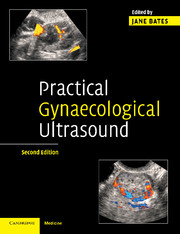Book contents
- Frontmatter
- Contents
- List of contributors
- Preface
- 1 Equipment selection and instrumentation
- 2 Practical equipment operation and technique
- 3 Anatomy, physiology and ultrasound appearances
- 4 Pathology of the uterus, cervix and vagina
- 5 Pathology of the ovaries, fallopian tubes and adnexae
- 6 Ultrasound in the acute pelvis
- 7 Ultrasound and fertility
- 8 Paediatric gynaecological ultrasound
- 9 Clinical management of patients: the gynaecologist's perspective
- Index
- References
5 - Pathology of the ovaries, fallopian tubes and adnexae
Published online by Cambridge University Press: 04 March 2010
- Frontmatter
- Contents
- List of contributors
- Preface
- 1 Equipment selection and instrumentation
- 2 Practical equipment operation and technique
- 3 Anatomy, physiology and ultrasound appearances
- 4 Pathology of the uterus, cervix and vagina
- 5 Pathology of the ovaries, fallopian tubes and adnexae
- 6 Ultrasound in the acute pelvis
- 7 Ultrasound and fertility
- 8 Paediatric gynaecological ultrasound
- 9 Clinical management of patients: the gynaecologist's perspective
- Index
- References
Summary
Introduction
Ultrasound has become an essential part of the gynaecological evaluation of the adnexae (which comprise the ovaries, fallopian tubes and broad ligament). In this chapter we will discuss the pathology, ultrasound imaging features and aspects of management of a range of conditions affecting the adnexae and conditions that may mimic adnexal pathology. We will concentrate on important or common conditions, with particular emphasis on the ovaries.
Clinical presentation
Patients referred for ultrasound examination of the pelvis may present with a range of symptoms. Pain is common and may be related to ovulation (mittelschmerz), menstruation (particularly in endometriosis) or intercourse (dyspareunia). Chronic pain may indicate pelvic inflammatory disease (PID) and acute severe pain may herald an emergency in the form of ovarian torsion or ectopic pregnancy. However some women complain of pressure rather than pain, often related to masses causing compression and displacement of pelvic organs. The close proximity of the adnexae to other organs may produce gastrointestinal or renal tract symptoms, which may misdirect the clinical evaluation away from the real cause for the complaint. Bloating and distension, though non-specific, are symptoms that may suggest ascites or massive ovarian tumours.
Alteration to the normal menstrual cycle, with irregular bleeding or amenorrhoea, and infertility or subfertility are further indicators of ovarian pathology ranging from polycystic ovary syndrome (PCOS) to hormone-secreting tumours.
Increasingly, with improvement in technology and increase in the demand for examinations, pathology is being discovered incidentally on imaging examinations for unrelated complaints.
- Type
- Chapter
- Information
- Practical Gynaecological Ultrasound , pp. 79 - 102Publisher: Cambridge University PressPrint publication year: 2006



